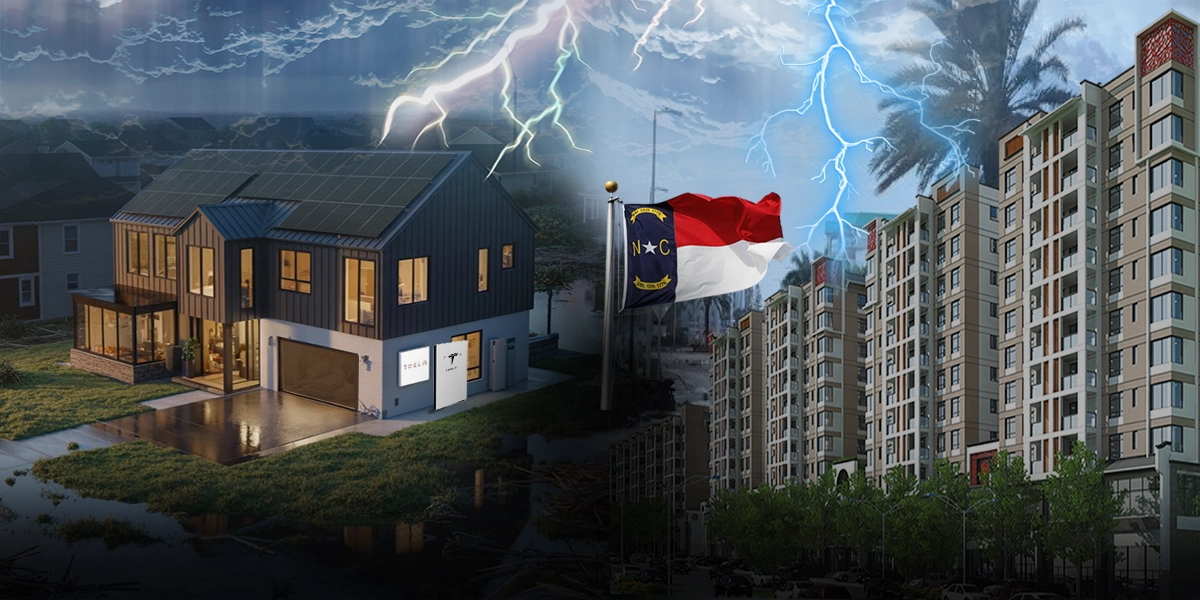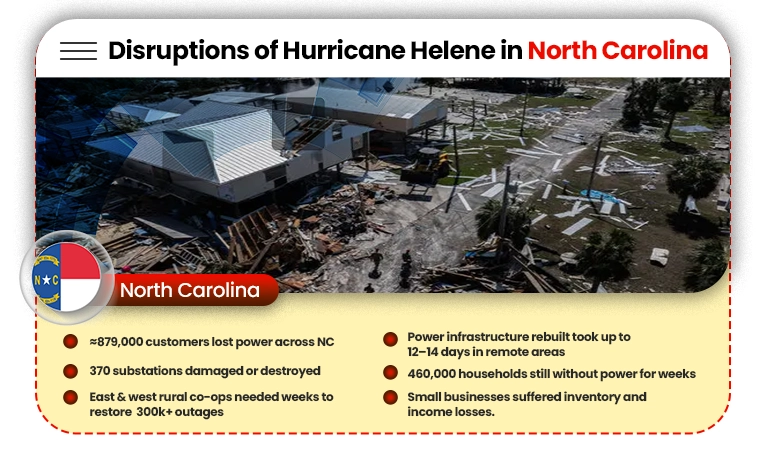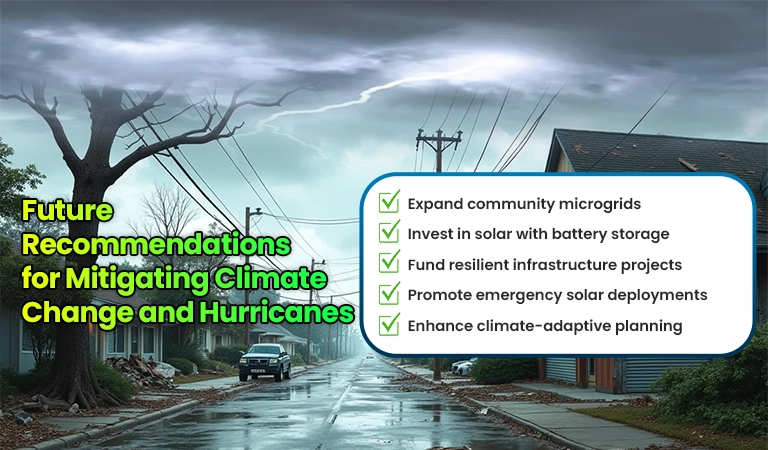- Published On:
How Solar and Battery Storage is Helping North Carolina Residents to Recover After Hurricane Helene
Hurricane Helene reached North Carolina on Friday, September 27, 2024, bringing historic rainfall, strong winds, and tornadoes. Helene’s impacts, particularly flooding and landslides, have made it one of the deadliest US storms of the 21st century. More than 100 confirmed deaths in North Carolina alone. Over 395,000 North Carolina residents lost power due to the storm’s catastrophic flooding and high winds. In this critical situation, solar and battery storage technologies played a vital role in disaster response and recovery efforts in Western North Carolina. Innovative microgrid installations helped restore power to some critical facilities faster than traditional grid infrastructure could. Also, emergency mobile solar+storage deployments brought relief to isolated rural communities.

Hurricane Helene: An Overview of Disruptions
North Carolina communities experienced nonstop heavy rain for three days. This caused roads to be washed out, resulting in catastrophic landslides, prolonged power outages, and water shortages. It was dubbed “one of the worst storms in modern history” by Governor Roy Cooper.
Western North Carolina has seen major effects from Hurricane Helene. The storm damaged thousands of homes, in addition to the tragic death toll. Millions of North Carolinians were deprived of essential utilities, including electricity, telephone, water, and medical facilities. In addition to preventing resident exit and entry for critical emergency and recovery teams, the damage to thousands of miles of roads and bridges shut off towns. A serious blow to the region’s economy has threatened livelihoods and the long-term sustainability of communities.

The state’s estimated damage is more than $59.6 billion. It includes $44.4 billion in direct damage, $9.4 billion in indirect or induced destruction. Also, $5.8 billion in possible investments for mitigation and protection.
Power outage was the most critical outcome of the hurricane. Thousands of people in the Carolinas were still without power for more than two weeks. The old grid wiring could not take the pressure of the storm. Resultantly, for thousands of citizens, there were no refrigeration for medication, no availability of a phone line, and no running water, especially in the rural areas. People in the mountains of western North Carolina were especially hard to reach. And it was not clear when there will be power on.
Role of Solar with Battery Storage During the Hurricane Helene:
Let’s have a look at how home solar energy solutions helped the community during the power losses due to Hurricane Helene in North Carolina:
Hot Springs Microgrid:
Like the rest of the region, Hot Springs lost power as Hurricane Helene passed inland. But it had a microgrid, unlike Asheville. The Department of Transportation gave Duke Energy access to Hot Springs via the French Broad River bridge post-storm, and Duke resolved some minor microgrid-related problems, such as low batteries. The town was still estimating damage when the microgrid was able to aid with the load. When flood areas were cleared as safe to resume power, the microgrid supplied electricity to the critical infrastructure of the town.
Hot Springs was powered by the microgrid for over a week before the town was switched back to the rest of the utility grid via a mobile substation.
The Role of Community Solar in Barnardsville:
Due to its isolation, many inhabitants of Barnardsville, a rural village 20 miles north of Asheville, were unable to get essential services. In Western North Carolina, there were other relief initiatives popping up. Sundance Power Systems, a solar installation company in Weaverville, worked to gather supplies stored in local garages and basements of his solar industry friends, and he started spreading the word about the need for donated batteries and solar gear. Many communities’ solar farms supported in powering up critical places like hospitals and communication services. Coordinating this effort was challenging due to the lack of cell service across the region.
Footprint Project: A Non-Profit Organization's Efforts:
A non-profit group called Footprint Project helps communities heal from disaster. They offered emergency assistance with resilient power technologies. Two solar and battery storage trailers that Footprint brought to Barnardsville were capable of providing vital community buildings with power and offering a Starlink internet connection.
After the restoration of grid power in Barnardsville, Footprint Project workers started looking for other communities in need. They set up their base and sourced solar and battery storage devices. Those donations sparked the establishment of the Free Store in Asheville, offering companies, organizations, and individuals still in need of stable power months after the storm free, long-term leases of solar and storage units.
Firestorm Book Store with Solar and Battery Installation:
Firestorm Books, a bookstore in West Asheville, played a vital role during Hurricane Helene. The bookstore was equipped with a solar and battery storage solution. When the grid was not working for days, the commercial solar solution helped residents with charging their phones and lights, storing food and medicines during the outages.
What are the Future Recommendations for Mitigating Climate Change and Hurricanes?
In Western North Carolina, disaster relief activities are still continuing, and there is still a need for both equipment and plans for future resilience. According to the Executive Director of the North Carolina Sustainable Energy Association (NCSEA), “There is a real opportunity in this moment to ensure we are elevating the value of solar and battery storage solutions, and how it can help the region better prepare for future storms,”.

● While still recovering from the crisis, local organizations are trying to keep up this momentum. In rural areas, Electrify Asheville-Buncombe is promoting the use of solar and battery storage to power drinking water wells. To support fully mobile equipment for those with electricity-dependent medical needs, NCSEA, Greentech Renewables, and the Land of Sky Regional Council are conducting an ongoing fundraising campaign. The objective is to build community solar projects and community resilience hub infrastructure in areas where low-income people live, like rural areas.
● Additionally, NCSEA promotes increased state grant financing for microgrids that supply vital infrastructure like water and telecommunications. The Footprint Project continues to support fundraising efforts in the area for further mobile solar + storage equipment.
● Duke Energy intends to increase microgrid deployment in the area, particularly to strengthen energy resilience in rural areas with a history of extended outages, using the Hot Springs microgrid as a lesson.
In conclusion, with climate change, hurricanes and storms are becoming more frequent in the United States. Also, the traditional grid infrastructure is not capable of powering communities during bad weather. On the other hand, electricity is a basic need, and it is not possible to survive without it for days. Solar with battery storage is the only economical option for homes, businesses, and utilities to mitigate the energy crisis. Especially the states prone to frequent storms, like North Carolina, Texas, etc., must work on the state level to build solar microgrids to support the electric grid during the bad weather conditions. There is also a need for community solar projects for people who cannot afford to install solar panels at home.
Solar SME is a trusted solar installer near you, offering affordable residential, commercial, and community solar solutions. You can get a FREE Quote for estimation.
